Samsung's Galaxy S 4: Introduction & Hands On
by Anand Lal Shimpi on March 14, 2013 7:30 PM EST- Posted in
- Smartphones
- Samsung
- Mobile
- Galaxy S 4

Since 2010 Samsung has grown to become not only the clear leader in the Android smartphone space, but the largest smartphone manufacturer in the world. Its annual iteration of the Galaxy S platform is now arguably one of the most widely anticipated smartphone launches each year.
Like clockwork, tonight Samsung announced the Galaxy S 4: a 5-inch 1080p smartphone, and the new flagship for the Galaxy brand. We just finished learning about the device and spent a short time playing around with it.
Most of the hardware specs are known quantities. The 5-inch Super AMOLED display features a 1080p resolution, for a pixel density of over 441 ppi. The chassis is plastic with a metallic looking rim around the edge. Like most Samsung devices, the Galaxy S 4 feels well built although the plastic construction makes it the polar opposite of HTC's One - and truthfully in a different league altogether. I don't personally believe Samsung's use of plastics is terrible, but it definitely doesn't lend itself to the same sort of remarkable designs we see from HTC or Apple. On the plus side the SGS4 feels very light (it's even lighter than the SGS3). The tradeoff between material feel and weight is one that has a spectrum of solutions. Samsung remains on prioritizing weight and cost, which is understandable given the success the company has seen thus far.
The SGS4 feels surprisingly comfortable in hand, partly due to weight and party due to the device's proportions. I didn't mind the size at all.
The Galaxy S 4 is available in two colors: white frost and black mist. I played with an international SGS4 variant in white frost.
| Smartphone Spec Comparison | ||||||
| Apple iPhone 5 | HTC One | Samsung Galaxy S 3 | Samsung Galaxy S 4 | |||
| SoC | Apple A6 1.3GHz | Snapdragon 600 1.7GHz | Snapdragon S4 1.5GHz | Exynos 5 Octa (1.6/1.2GHz) or Snapdragon 600 1.9GHz | ||
| DRAM/NAND/Expansion | 1GB LPDDR2, 16/32/64GB NAND | 2GB LPDDR2, 32/64GB NAND | 2GB LPDDR2, 16/32GB NAND, microSD | 2GB LPDDR3, 16/32/64GB NAND, microSD | ||
| Display | 4.0-inch 1136 x 640 LCD | 4.7-inch SLCD3 1080p, 468 ppi | 4.8-inch Super AMOLED 720p, 306 ppi | 5-inch Super AMOLED 1080p, 441 ppi | ||
| Network | 2G / 3G / 4G LTE Cat 3 | 2G / 3G / 4G LTE Cat 3 | 2G / 3G / 4G LTE Cat 3 | 2G / 3G / 4G LTE Cat 3 (depending on region) | ||
| Dimensions | 123.8mm x 58.6mm x 7.6mm | 137.4mm x 68.2mm x 4mm - 9.3mm | 136.6mm x 70.6mm 8.6mm | 136.6mm x 69.8mm x 7.9mm | ||
| Weight | 112g | 143g | 133g | 130g | ||
| Rear Camera | 8MP | 4MP w/ 2µm pixels | 8MP | 13MP | ||
| Front Camera | 1.2MP | 2.1MP | 1.9MP | 2MP | ||
| Battery | Internal 5.45 Wh | Internal 8.74 Wh | Removable 7.98 Wh | Removable 9.88 Wh | ||
| OS | iOS 6.1.2 | Android 4.1.2 | Android 4.1.2 | Android 4.2.2 | ||
| Connectivity | 802.11a/b/g/n, BT 4.0, USB 2.0, GPS/GNSS | 802.11ac/a/b/g/n + BT 4.0, USB2.0, GPS/GNSS, MHL, DLNA, NFC | 802.11a/b/g/n, BT 4.0, USB 2.0, NFC, GPS/GNSS, MHL | 802.11a/b/g/n/ac (HT80) + BT 4.0, USB 2.0 NFC, GPS/GNSS, IR LED, MHL 2.0 | ||
The back cover remains removable, as does the 9.88Wh battery:
Internally, there’s 2GB of memory and 16 - 64GB of on-board NAND, with a microSD card slot for optional storage expansion.
As expected, the SoC will vary depending on region. Samsung will offer either its own Exynos 5 Octa or a 1.9GHz quad-core Snapdragon SoC from Qualcomm. Given the clock speed and the timing, I would assume Samsung is talking about a Snapdragon 600 but the only official word from Samsung is the 1.9GHz quad-core Snapdragon. Update: Qualcomm has confirmed that this is a Snapdragon 600.
The Exynos 5 Octa side is a bit more interesting. Samsung is calling the SoC a 1.6GHz Octa-core part, but that appears to be the clock speed for the four Cortex A7 cores. The four Cortex A15 cores will run at up to 1.2GHz, which should help keep power consumption manageable. We’ve been wondering for a while what clock speeds we’d see the Cortex A15s run at in smartphones, and I believe this is the first line drawn in the sand. If we go back to Samsung’s ISSCC disclosure of Exynos 5 Octa power consumption, it looks like peak CPU power consumption should be somewhere around 2W - definitely better than what we saw from Exynos 5 Dual in the Nexus 10. Again, no surprises here given that we’re talking about a smartphone - it’s just interesting to see. Update: There seems to be some confusion as to whether or not the A7/A15 clocks are 1.6/1.2 or 1.2/1.6. I was told the former and that's what I wrote down, but it's entirely possible that the information given wasn't correct. I'm awaiting for further confirmation. Although 1.2GHz makes sense for a max clock for the A15s, 1.6GHz is a bit high for A7s if they're truly to be used to keep power consumption down. I can see it working either way.
Samsung isn’t ready to talk specifics about what SoCs will end up in what regions. We weren’t allowed to run any downloaded applications or benchmarks on the hardware at the event, nor were we told what SoCs were used in the demo hardware. Both SoCs should be good choices though.
Similarly, there’s no disclosure on what baseband silicon is being used although LTE support will be offered depending on the region. It’s highly likely that we’re looking at another MDM9x15 with a discrete applications processor (Snapdragon or Exynos 5 Octa). All of the expected wireless connectivity options are present including 802.11ac and BT 4.0. Samsung is claiming support global LTE roaming (up to six different bands) and FDD/TDD LTE.
As is the norm these days the Galaxy S 4 comes with both a front and rear facing camera. The front facing camera features a 2MP sensor and is capable of recording video at 1080p30. The rear facing camera sees a move to a 13MP sensor with flash. No word on the max aperture or focal length of the camera systems at this point.
The Galaxy S 4 will ship with Android 4.2.2. It will be available both internationally and in the US starting sometime in Q2 (Update: first shipments will be in April). US operators signed up to carry the Galaxy S 4 are AT&T, T-Mobile, Sprint, Verizon, Cricket and US Cellular.


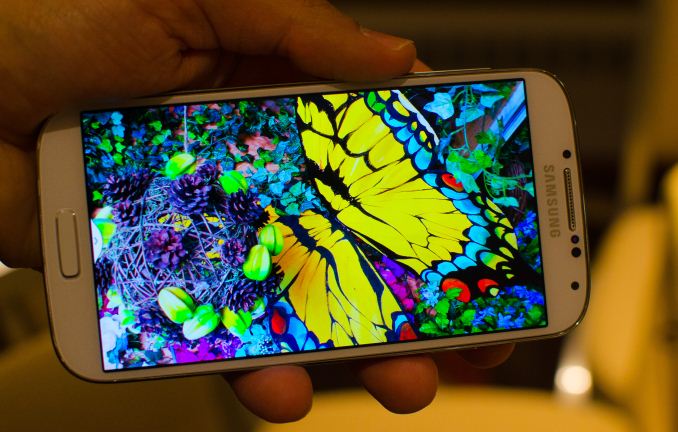
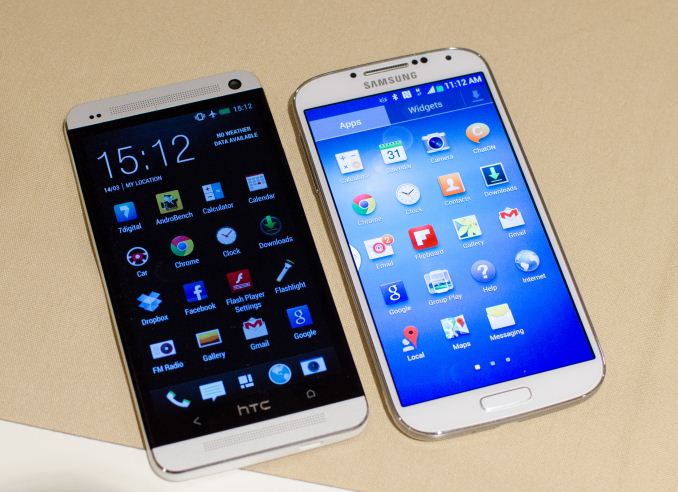

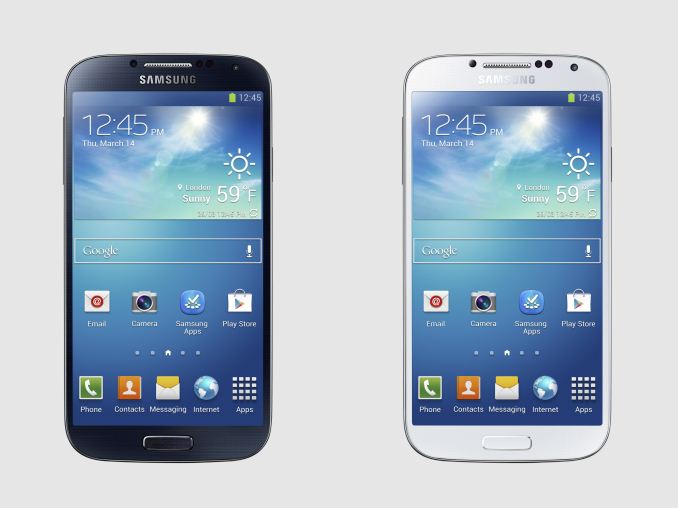
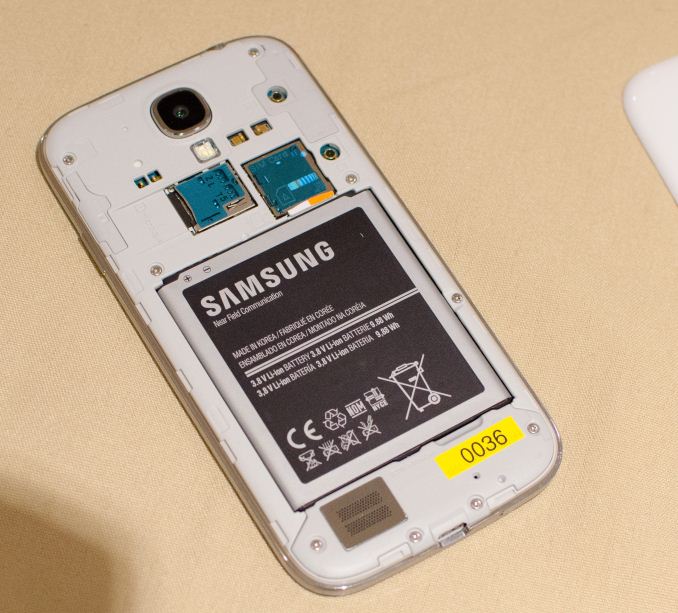
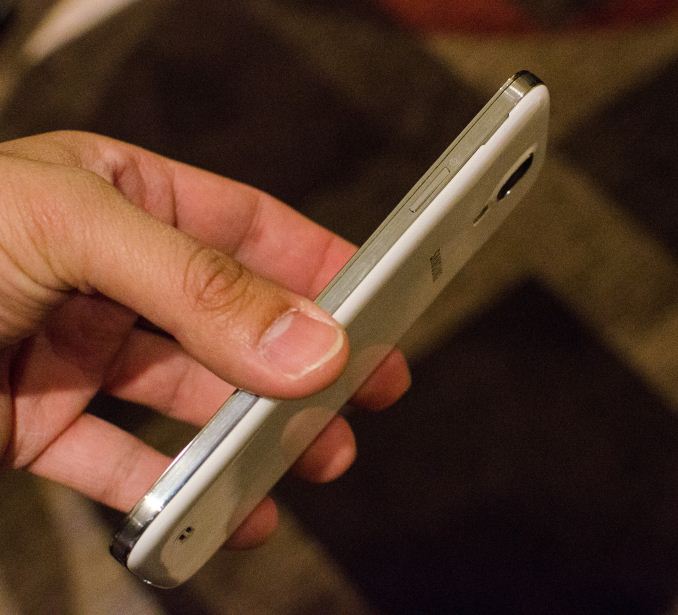















206 Comments
View All Comments
WaltC - Saturday, March 16, 2013 - link
Why list the PPI of every phone except the iPhone? Don't want to embarrass Apple?CeriseCogburn - Saturday, March 16, 2013 - link
Sounds right, you know how that internal fanboyism filter works.Science and stats becomes the drooling monkey as soon as the perceived Politically Correct winner is about.
WaltC - Wednesday, March 20, 2013 - link
Well, it's at least wonderful that we don't have to struggle through "Retina Display" comments as though the phrase meant something profound...;) I always preferred "Retsina Display" anyway.akdj - Wednesday, March 20, 2013 - link
Why such hatred for Apple/iPhone in these comments? Seems to become more and MORE ubiquitous....regardless of Anand's reviews. I'm a fan of both--I'm an owner of a Galaxy Note and iPhone 5. This would make a helluva 'thesis' for a graduate student in Psychology/Psychiatry!!! LOL. Too many of you folks spend WAY too much time beating up iPhone users, Apple's design philosophy and/or the silly 'benchmarks' that truly mean nothing when compared to 'real world' experience. I'm excited for the GS4. I can't get rid of my OG GNote fast enough. It's buggy and slow as hell---but dicking around with the Note 2, I've noticed a significant improvement in UI 'speed' and overall usability. I suppose this is to be expected from a gen 1 device (My Note 1)---but Good Lord!!! It seems not a single page in these 18 of comments lack a bash or poke to the eye of the iPhone or their owners. Words like 'retarded' are pretty lame...and definitely reveal the intelligence of said posters. Plenty of folks are asking valid questions and add interesting information to the discussion---but again, Where is this 'hate' coming from? Is it envy? As an iOS and Android developer...as well as Windows and OSx everyday user...it kicks my ass that so many people HERE, on one of the MOST respected 'geek' sites on Al Gore's inter-webs are so damned insecure when it comes to Apple products. I just don't get it. There really, truly is absolutely NO need to even bring the iPhone into the discussion. Anand didn't---other than a single mention or two when it comes to design aesthetics. Along with HTC and the use of aluminum vs. plastics. I don't mind the plastic on my note--and I definitely appreciate the easy access to my SD storage and battery---but when it comes down to the nit 'n grit, I do prefer the solidity of aluminum/metal construction. As well---the MOST complained about 'feature' if you will of Sammy phones IS the construction (use of plastic). Again, I don't necessarily agree that being the most detrimental issue on Samsung mobile devices. I just find it ridiculous the extent some will go to in order to slam what Apple is doing! Quite over the top---especially considering Apple's contribution to Smart Phone technology (along with Samsung/Google) back in '07.**Rant Over**
WaltC - Wednesday, March 20, 2013 - link
Feeling better?...;) Now, calm yourself and take a look at the table above entitled: "Smartphone Spec Comparison." If there's not an iPhone in there I'll eat my hat...;)frombauer - Sunday, March 17, 2013 - link
I would really like to see Samsung (or HTC) release a smaller version of these flagships. 5" is too big for me, give us the option to have a 4-4.3", quad-core, 2GB RAM, 720p phones!kascollet - Sunday, March 17, 2013 - link
+1000A small high end phone pleeeeaaaase !
ATBTCT - Sunday, March 17, 2013 - link
Despite the 5 inch screen this phone is the same size as S3 and HTC ONE.Mugur - Monday, March 18, 2013 - link
Yes, most people failed to noticed that... :-). It's not the size of the screen, but the size of the phone, people. Also it is 11 mm wider and 13 mm taller than an iPhone 5. It's not the size of a ping-pong pallet...kascollet - Monday, March 18, 2013 - link
Yes, that's too big for me.